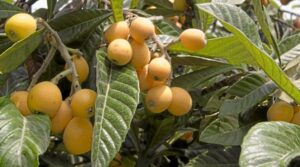Medlar of Japan – Eriobotrya Japonica

The Japanese medlar or Japanese medlar, scientifically known as Eriobotrya japonica, is a vigorous subtropical fruit plant, belonging to the Rosaceae family. It is an evergreen plant that produces tasty and healthy fruit, which can also be used for ornamental purposes. The leaves are very large (broad-leaved), with an expanded and thick globose crown. The Japanese Medlar plant needs targeted cultivation arrangements to bear fruit, since flowering occurs in autumn, between November and February, if at that time too cold or freezing temperatures occur, the tree may not bear fruit. This explains why, in Italy, it is widespread above all in the south.
GROUND
The Japanese medlar is an easily adaptable plant, but as it happens for many species, it badly tolerates water stagnation, which occurs on strongly clayey and compact soils, therefore it is preferable to plant it in a fertile and rich soil; As reported in the previous paragraph, due to flowering in winter, it prefers a more temperate climate, so it is advisable, if planted in colder areas, to plant it in a position sheltered from the cold and sunny even in winter. Cultivation in pots should not be excluded, taking into account that the plant can reach over 2 meters in height. The sixth of the plant for planting must be more or less than 5 meters between the plants and 5 meters between the rows.
FLOWERS AND FRUITS
The flowers of the Japanese medlar are collected in clusters and are ivory white, with five petals, and emit a very pleasant bitter fragrance. The scent of these flowers is very similar to that of hawthorn. A peculiarity of the Japanese medlar is the very long flowering that goes from November to February, a characteristic very appreciated by bees. The fruit ripens in spring; Medlars from Mediterranean crops are available on the market as early as March, while those of the Po Valley ripen around May. The average fruiting in full production is about 30 kg of fruit per plant. The fruits are about the size of small apricots, with large seeds (from 1 to 5 pcs) gathered in the center; the color of the peel ranges from pale yellow to bright orange; the pulp has a sweet and refreshing taste, the color ranges from white to orange, including different shades of yellow depending on the degree of ripeness.
USE AND HEALTHCARE CONTENT
Japanese medlars should be consumed only fresh; they have multiple beneficial properties: they are rich in mineral salts, anti-inflammatory and diuretic, they help intestinal and hepatic regularity, they are a mild antipyretic. Low-calorie, they protect against colon cancer, reduce the risk of developing cardiovascular disease, improve blood pressure, reduce blood cholesterol levels, help improve vision, counteract the harmful effects of free radicals thanks to their antioxidant action, replenish the liquids lost with sweat, therefore represent a panacea for sportsmen, clean up the urinary tract, prevent stones and infections, promote the expulsion of toxins. In addition, they counteract cellulite and the formation of fat pads, help eliminate excess fluids, are an excellent hunger breaker, giving a good feeling of satiety. Furthermore, Japanese medlars, thanks to beta-carotene, counteract wrinkles, preparing us for sun exposure.
PRUNING AND COLTURAL CARE
In nature, the foliage has a globular appearance and, to remain beautiful, it does not require pruning. Eventually, after the fruit has been harvested, a moderate pruning can be performed, aimed at eliminating the dried branches and those badly arranged in the foliage, without however exceeding. Generally 3-4 prolonged irrigations are necessary every year, divided into two periods: before harvesting (to favor fruit swelling) and after harvesting (to stimulate the production of buds).
